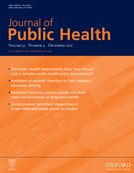Abstract:
BACKGROUND: Scientific evidence demonstrates a link between viewing time and several poor health outcomes. We use a reasoned action approach to identify the determinants and beliefs associated with parents’ intention to limit their children’s television viewing.
METHODS: We surveyed a random sample of 516 caregivers to children ages 3-16 in a large Northeastern city. Multiple regression analyses were used to test a reasoned action model and examine the differences across demographic groups.
RESULTS: The intention to limit viewing (-3 to 3) was low among parents of adolescents (M: 0.05) compared with parents of 3-6 year olds (M: 1.49) and 7-12 year olds (M: 1.16). Attitudes were the strongest determinant of intention (β = 0.43) across all demographic groups and normative pressure was also significantly related to intention (β = 0.20), except among parents of adolescents. Relevant beliefs associated with intention to limit viewing included: limiting television would be associated with the child exercising more, doing better in school, talking to family more and having less exposure to inappropriate content.
CONCLUSIONS: Attitudes and normative pressure play an important role in determining parents’ intention to limit their child’s television viewing. The beliefs that were associated with parents’ intention to limit should be emphasized by health professionals and in health communication campaigns
Authors
- Amy Bleakley
- Michael Hennessy
- Amy Jordan
- Jessica Taylor Piotrowski


